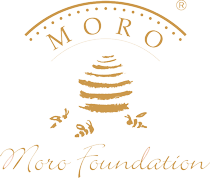| [slidepress gallery=’cebelarski-muzej’] | The bee has carried a magical-religious meaning since prehistoric times. It symbolizes spiritual virtue and extraordinary human capacity. Its symbolism is based on diligence, the value of its product and the meticulous organization of its hive. The bee has been a symbol of states and rulers; in some religions it symbolized immortality.
Throughout the millenia the symbolic function of the bee has been preserved and developed through oral tradition and a rich iconography. The image of the bee and the beehive are most often used in connection with saving – as an expression of meritoriousness and strenuous work. Bee and honey motifs also occur in proverbs of various languages to convey wisdom, to educate and to offer advice. The average Slovene person sees the bee as a precious and noble insect, not just as an economically profitable creature. Ljubljana’s ACADEMIA OPEROSORUM erudite society used the bee and beehive in its coat-of-arms to illustrate the society’s purpose – collecting members’ knowledge and sharing it for the benefit of everyone. |
|
The founding members of the Academy also used a bee in their emblems. A special place in the history of Slovenian apiculture is held by ANTON JANŠA (1734-1773), who was the first apiculture teacher at the Imperial apiculture school in Vienna. Janša published two important works describing his research in bee biology, which made important contributions to 18th century apiculture and resulted in pragmatic technological innovations. Priest PETER PAVEL GLAVAR (1721-1784) was also a leading apiculturist of his time. He presented his beekeeping improvement plan in Carniola, provided useful advice on apiculture and contributed several important development recommendations. The authothonous Carniola bee (Apis mellifera carnica), also known as the GREY BEE OF CARNIOLA, is treasured among beekeepers throughout the world for its outstanding characteristics. From the beginning of the bee trade in 1857 until World War One, Slovenian bee merchants sold about 200.000 queen bee colonies and queen bees. The Carniola grey bee thus became the second most widely spread bee type in the world. The Museum of Apiculture in Radovljica, which opened its doors to visitors 50 years ago, is the only one of its kind in Slovenia and holds a stunning collection of Slovenia’s rich apriculture legacy. The Museum presents the autochthon race of the Carniola bee, holds important documentation written by beekeepers and apiculturists and has a stunning collection of ’PANJSKE KONČNICE’ – painted front wooden panels of beehouse-boxes that are also known as ‘kranjiči’ (the little Carniolians). With its rich motifs, the panels are a unique and indispensable part of the folk art and culture; through their painted representations of religious, common, tragic and humourous themes, the panels serve as documentation of the mannerism and sentiment of the time and – what is perhaps most essentially – they form an integral part of the Slovene cultural identity. Ida Gnilšak, Museum of Apiculture in Radovljica |
|



